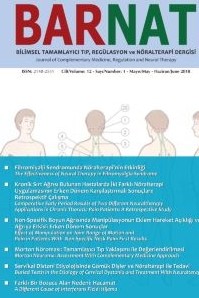TEMPOROMANDİBULAR EKLEM DİSFONKSİYONU BULUNAN HASTALARDA FİBROMİYALJİ SENDROMUNUN GÖRÜLME SIKLIĞI
Temporomandibular eklem disfonksiyonu, fibromiyalji sendromu, miyofasiyal ağrı, disk deplasmanı
PREVALENCE OF FIBROMYALGIA SYNDROME IN PATIENTS WITH TEMPOROMANDIBULAR JOINT DYSFUNCTION
Temporomandibular joint dysfunction, fibromyalgia syndrome, myofascial pain, disc displacement,
___
- 1. Auvenshine RC. Temporomandibular disorders: associated features. Dental clinics of North America 2007;51:105-127, vi. 2. McNeill C. Management of temporomandibular disorders: concepts and controversies. The Journal of prosthe? c den? stry 1997;77:510-522. 3. Moreno-Fernandez AM, Jimenez-Castellanos E, Iglesias-Linares A, Bueso- Madrid D, Fernandez-Rodriguez A, de Miguel M. Fibromyalgia syndrome and temporomandibular disorders with muscular pain. A review. Modern rheumatology 2017;27:210-216. 4. Huber MA, Hall EH. A comparison of the signs of temporomandibular joint dysfunc? on and occlusal discrepancies in a symptom-free popula- ? on of men and women. Oral surgery, oral medicine, and oral pathology 1990;70:180-183. 5. Goldstein BH. Temporomandibular disorders: a review of current understanding. Oral surgery, oral medicine, oral pathology, oral radiology, and endodon? cs 1999;88:379-385. 6. Suvinen TI, Reade PC, Kemppainen P, Kononen M, Dworkin SF. Review of ae? ological concepts of temporomandibular pain disorders: towards a biopsycho social model for integra? on of physical disorder factors with psychological and psychosocial illness impact factors. Eur opean journal of pain 2005;9:613-633. 7. Laskin DM, Greene CS, Hylander WL. Temporomandibular disorders: An evidence-based approach to dia gnosis and treatment. (1.Baskı). ABD: Quintessence Yayınevi, 219-228 8. Fujarra FJ, Kaziyama HH, Siqueira SR, Yeng LT, Camparis CM, Teixeira MJ, et al. Temporomandibular disorders in fi bromyalgia pa? ents: are there diff erent pain onset? Ar quivos de neuro-psiquiatria 2016;74:195-200. 9. Nazlıkul H. Fibromiyalji Sendromu (FMS). Bilimsel
- ISSN: 2148-2551
- Başlangıç: 2006
- Yayıncı: Bilimsel Nöralterapi ve Regülasyon Derneği
Özden Sibel ODABAŞI, Dilek DİZDAR
BOZUCU ALAN OLARAK DİŞ ve SİNÜSLERİN NEDEN OLDUĞU KRONİK TOPUK AĞRISI
TEMPOROMANDİBULAR EKLEM DİSFONKSİYONU BULUNAN HASTALARDA FİBROMİYALJİ SENDROMUNUN GÖRÜLME SIKLIĞI
Güzin Neda HASANOĞLU ERBAŞAR, Fatma Gülçin URAL
HİRUDOTERAPİ KOMPLİKASYONU OLARAK ENFEKSİYON OLGUSU
Cüneyt TAMAM, Banu TAMAM, Yusuf TAMAM
